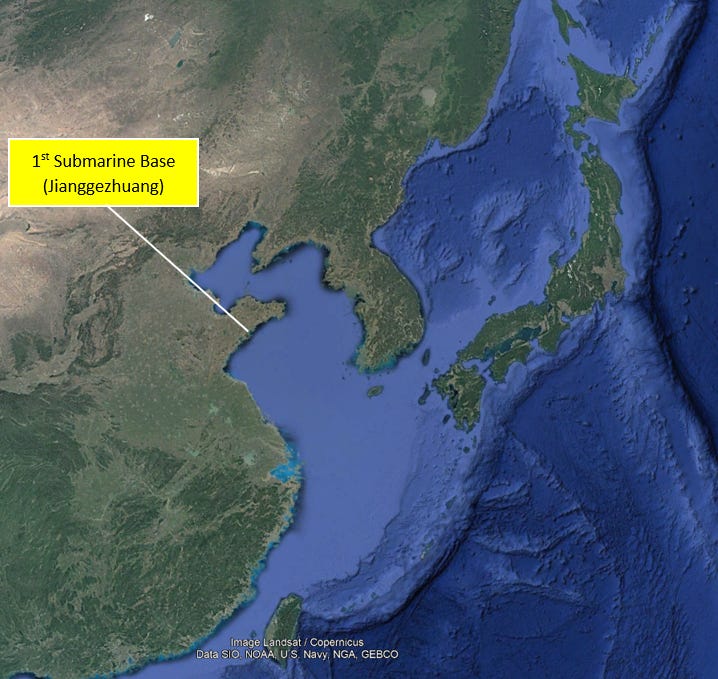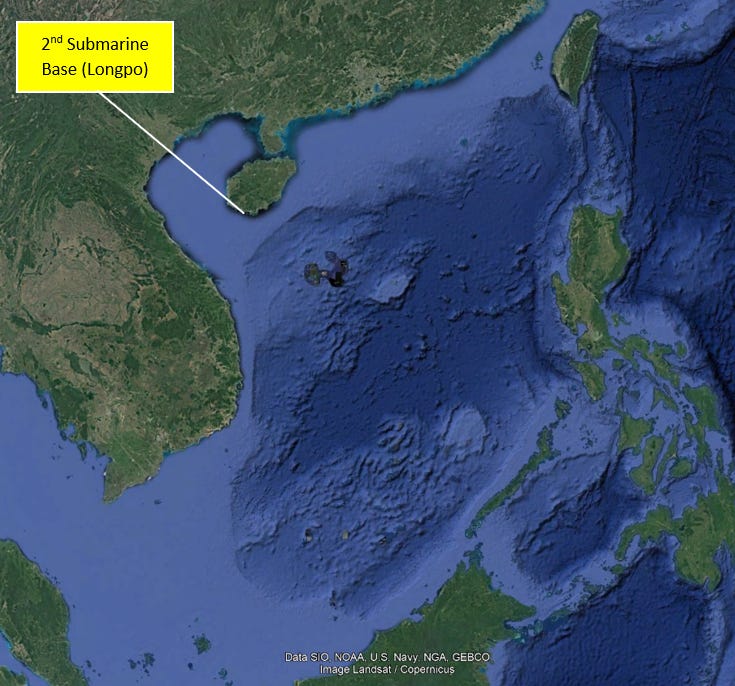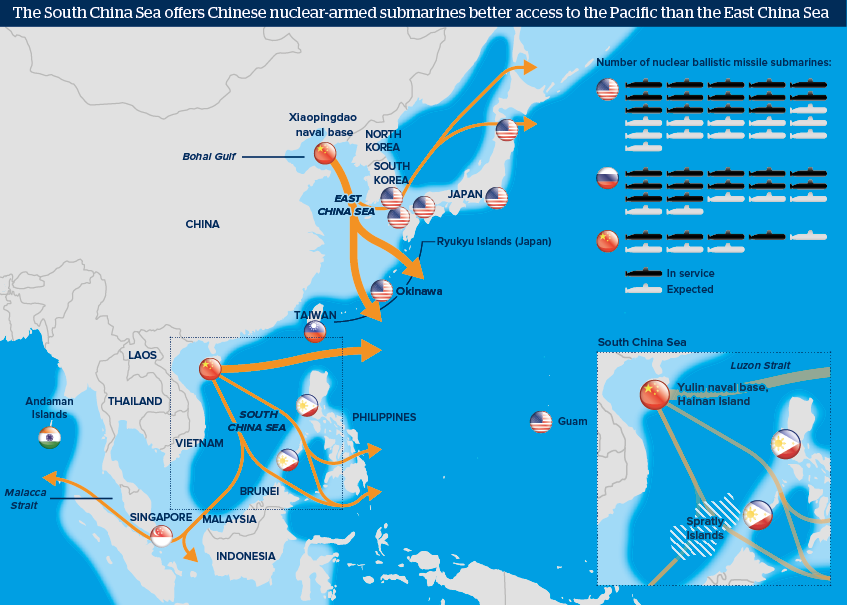"Strategic Depth: The Connection between Taiwan's East Coast and Chinese Submarines"
By Alpheidae
Strategic Depth: The Connection between Tainwan´s East Coast and Chinese Submarines
When thinking about China and Taiwan and the reasons why this issue might lead to military action in the future, certain themes rightly dominate the discussion, analysis and predictions. These include China's demographic decline, Taiwan's economic importance and China's claim to Taiwanese sovereignty. To explore and present another idea of a so-called "benefit" that might be of interest to China in escalating a conflict with Taiwan; one might consider the use of ballistic missile-armed nuclear submarines (SSBNs) and the second-strike capability and overall presence that this entails.
To do this, I will first provide a brief overview of the PLAN (People's Liberation Army Navy) and its existing submarines and submarine bases, and then immediately move on to the potential limitations and challenges that these bases may pose in the future. Having laid this groundwork, I would like to present how the Taiwanese East Coast could theoretically be of interest to the PLAN, as it would benefit them in meeting these challenges in the future.
The PLAN submarine capabilities and limits
As of August 2024, the PLAN has a total of about 60 unique submarines. 48 SSKs of various classes (ship, submarine, hunter-killer), 6 Shang Class (Type 093) SSNs (ship, submarine, nuclear), and 6 Jin Class (Type 094) SSBNs (ship, submarine, ballistic, nuclear).[1]
The latter is of particular interest for this blog entry as it is the only one to carry 12 JL-2/ CSS-N14 SLBMs (submarine-launched ballistic missiles) with an effective range of ~7,000+ km.[2]
These ships are mainly stationed at two underground PLAN submarine bases: the first is at Jianggezhuang, which is part of the Northern Theatre (Figure 1) and hosts SSKs and SSNs, while the second one is in Longpo, which belongs to the Southern Theater Navy (Figure 2) and hosts SSBNs.[3]

Having made this very limited and focused assessment of the main submarine force and its bases, it is now time to look at some of the limitations and problems associated with these bases, starting with the first base at Jianggezhuang.
In terms of location, it only provides easy access to the ECS (East China Sea) and the Sea of Japan, both of which are rather shallow and close to US, Japanese and South Korean forces, limiting the possibility of operations involving nuclear submarines as they would be easily detected, which also affects the effective use of SLBMs (Figure 3)[4]. Given these limitations, one wonders why the base was built in the first place,
„[…], this has to be seen in context of the time it was built, when the primary adversary of China was the erstwhile Soviet Union. Given the limited range of the JL-1 strategic missile that was carried by the sole PLAN Xia-Class (Type 09-II) SSBN, it made sense to build a base towards the north, putting at least a few major population centres in the Soviet Union within missile range.“[5]
The second base at Longpo offers better options, with deeper waters in the SCS (South China Sea) and more distance from the forces of opposing nations. It also offers a better route to the Phillipine Sea and the Pacific, if one enters through the Luzon Strait between Taiwan and the Philippines. The main limitation to submarine operations here would be the limited capacity of the base itself. Although the naval base at Yulin, which is part of the same complex and hosts the PLAN's Southern Theatre Fleet, has been expanded in 2022[6], one might ask whether it is enough to keep expanding a single base, especially given the PLAN's efforts to build up to four to six new nuclear submarines per year.[7]

In sum, while China is actively expanding its SSN arsenal to further strengthen its nuclear triad and present a credible deterrent and second-strike capability to the United States, it is faced with limited operational space in the ECS and limited basing options in the SCS in terms of speed of build-up, all while being constantly monitored by operational forces and surveillance equipment in fairly close proximity. To meet these future challenges, the PLAN could draw on an idea from the past, which emerged in Taiwan.

Fortification from the East
In 2001, under the Bush administration, the US agreed to sell Taiwan several diesel-powered submarines in response to a 1995 request, and although the sale eventually fell through due to a lack of production capacity and China's strong opposition to the project, it was in this context that an idea was developed. This idea has resurfaced now that Taiwan is testing its latest submarines, in an article from the SCMP (South China Morning Post), so please keep the source in mind when following this idea.
The plan was to build an underground submarine base in the existing underwater caves along the east coast of Taiwan and its mountains to house the newly acquired diesel-electric submarines from the US. The location would offer tremendous advantages in the form of natural cover from the mountains above and easy access to deep water just off the coast leading directly into the Philippine Sea. These pre-existing caves could theoretically be converted into formidable submarine bases to defend the island from China. While this sounds great in theory, in reality the whole project was considered too expensive, and the limited range of diesel-electric submarines made stationing them in the north more realistic.[8]
While this idea may not have worked for the Taiwanese, it may give the CCP (Chinese Communist Party) another reason to escalate its efforts against Taiwan, in addition to those mentioned above. Why?
Because if the PLAN were to implement this plan to build this base and make the idea a reality, it could solve the proposed problems I mentioned earlier. It could serve as a new homeport for the SSNs currently under construction, and it would open up the possibility of basing these new submarines. The biggest selling point would be the immediate proximity to deep water, which would make it easier for submarines to evade detection by diving below the ocean's thermocline layer directly into the Philippine Sea and the Pacific Trench immediately thereafter, posing a credible threat in terms of second-strike capability and therefore deterrence, because they could be armed with balistic missiles. Especially considering that the primary adversary at the moment would be the US, avoiding detection while being able to dive directly towards the US west coast would only encourage that idea, and since money should not be a problem for the CCP and limited range is not a problem for SSBNs, it might be something to keep in mind for the future.
[1] Nuclear Threat Initiative: „China Submarine Capabilities. Part of Submarine Proliferation Resource Collection“. 2024. https://www.nti.org/analysis/articles/china-submarine-capabilities/ (Access 27.11.24).
[2] Schiller, Dr.-Ing. Markus: “Der große Sprung? Chinas ballistisches Raketenprogramm. Ein technischer Bericht.” IFSH, Research Report 13. 2024. https://ifsh.de/publikationen/research-report/research-report-013. p.58 (Access 27.11.24).
[3] Khanna, Montay: “China’s Nuclear Submarine Bases: A Stocktaking”. Observation Research Foundation Special Report Nr.234. 2024. https://www.orfonline.org/research/china-s-nuclear-submarine-bases-a-stocktaking (Access 27.11.24).
[4] Ibid.
[5] Ibid.
[6] Yeo, Mike: “Satellite images reveal Chinese expansion of submarine base”. DefenseNews. 2022. https://www.defensenews.com/naval/2022/09/21/satellite-images-reveal-chinese-expansion-of-submarine-base/ (Access 27.11.24).
[7] Khanna, Montay: “Assessing the Submarine Training Capacity of the Chinese Navy”. Observation Research Foundation Special Report Nr.235. 2024. https://www.orfonline.org/research/china-s-nuclear-submarine-bases-a-stocktaking. p.14 (Access 27.11.24).
[8] Thanh Nien Newspaper: “Taiwan's plan to build a secret submarine base 'resurfaces' again”. 2023. https://www.vietnam.vn/en/ke-hoach-xay-can-cu-tau-ngam-bi-mat-cua-dai-loan-lai-noi-len/ (Access 27.11.24).

